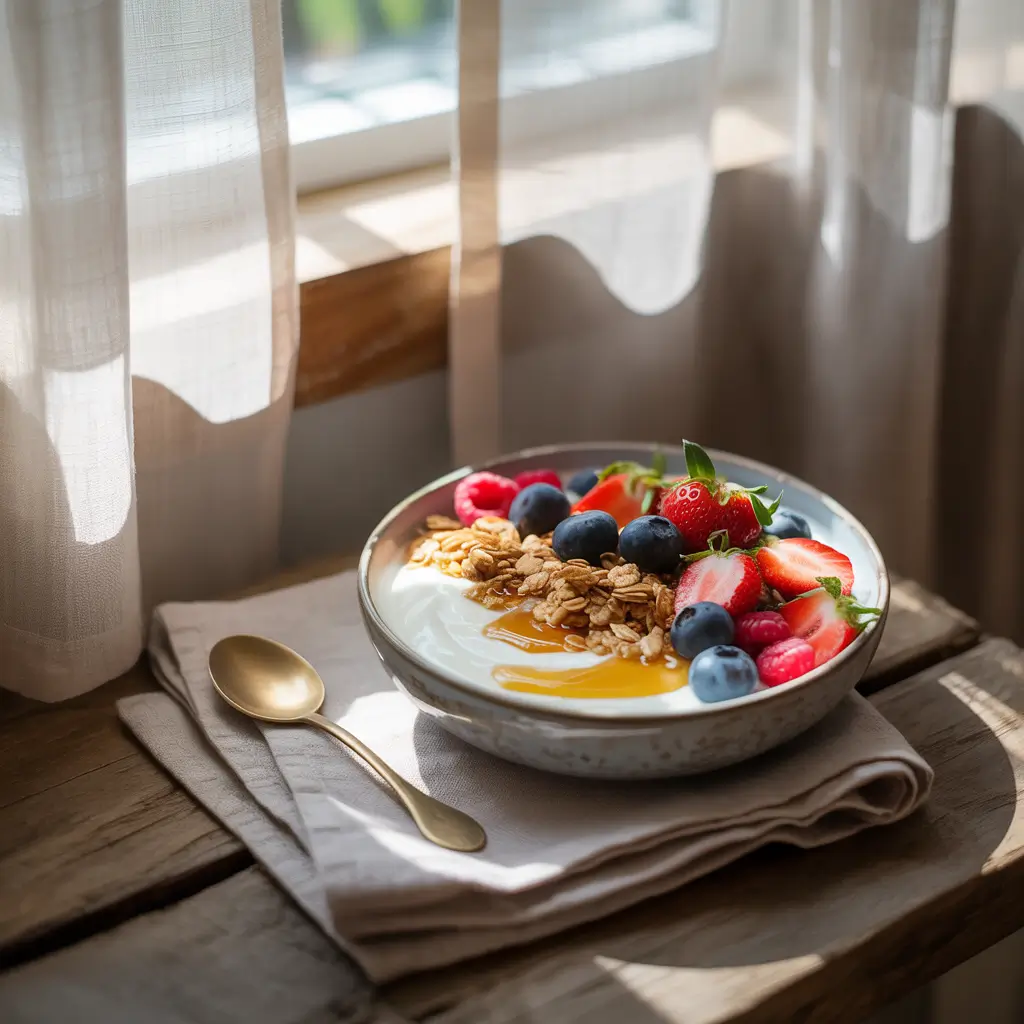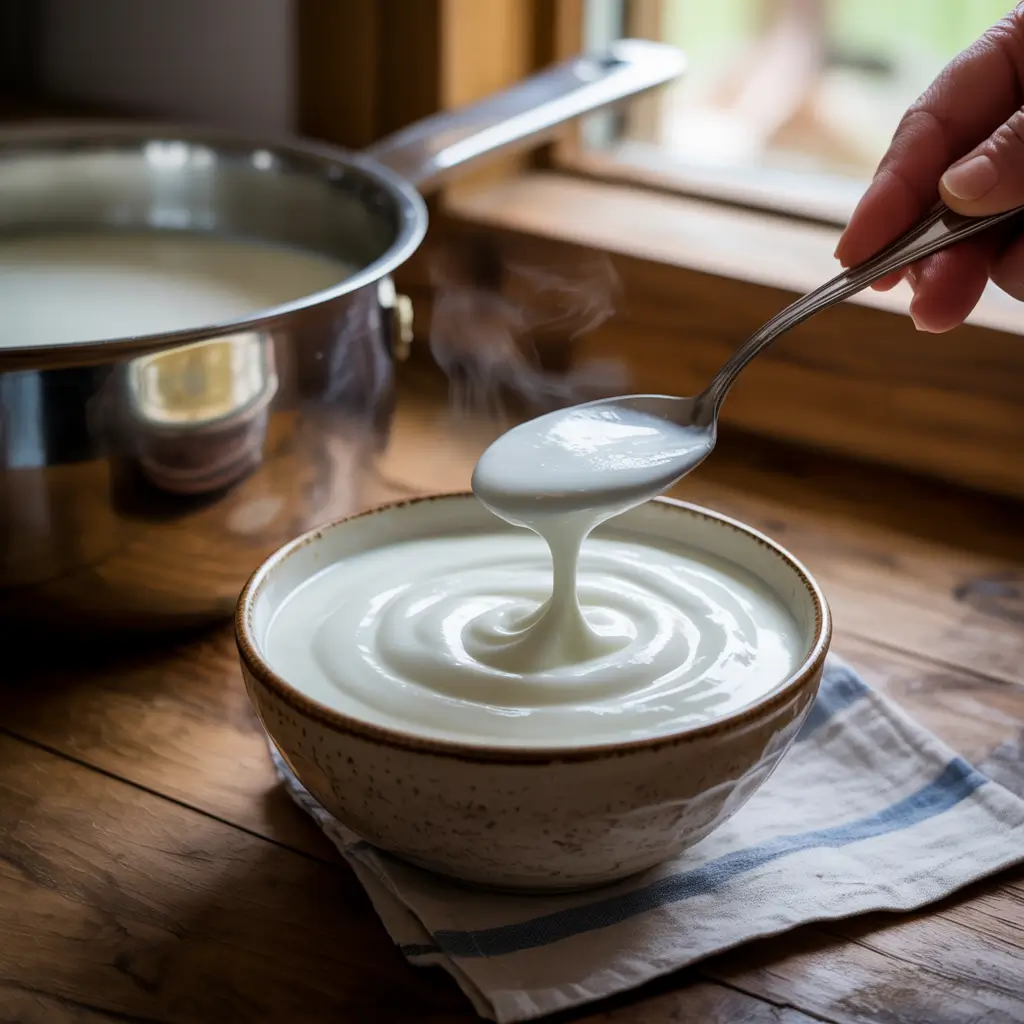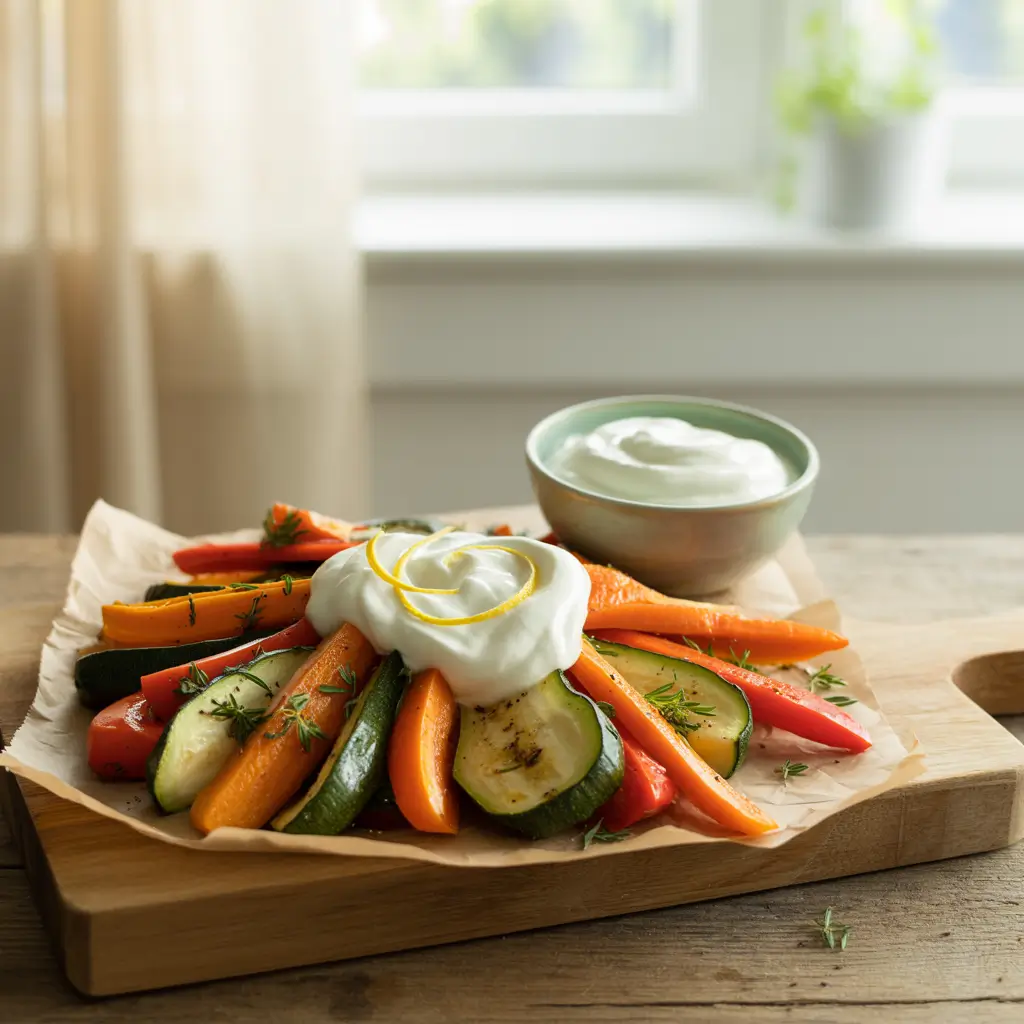Introduction
Yogurt cream top is more than just a creamy layer sitting on your yogurt—it’s a mark of quality, taste, and natural goodness. If you’ve ever peeled back the lid of an artisanal yogurt and found a rich, velvety cream sitting atop, you’ve encountered this traditional delight. In this comprehensive guide, we’ll explore everything there is to know about yogurt cream top, including its origins, nutritional benefits, and the best ways to enjoy it. Whether you’re wondering how to eat cream yogurt, curious about its differences from crème fraîche, or debating if you can replace cream with yogurt in your recipes—we’ve got you covered.
We’ll also dive into homemade methods, brand recommendations, and expert tips to ensure you never miss out on the luxurious experience of yogurt cream top. Don’t miss our article on the broader yogurt trend: Learn more about yogurt’s growing popularity here: https://www.zestolla.com/yogurt-in-a-bowl/.Explore more delicious ideas on our Pinterest board: https://fr.pinterest.com/gadeserahmed/
table of contents
Table of Contents
Yogurt Cream Top: The Ultimate Guide to Taste, Uses & Benefits
Discover the rich, velvety layer atop non-homogenized yogurt — a mark of quality, taste, and natural goodness. From origins to nutrition and delicious uses, learn all about yogurt cream top.
- Prep Time: 20 minutes
- Cook Time: 8 hours
- Total Time: 8 hours 20 minutes
- Yield: 4 servings
- Category: Dairy
- Method: Fermentation
- Cuisine: Traditional
Ingredients
- Full-fat non-homogenized milk
- Live culture yogurt (starter)
- Fresh fruits (optional)
- Honey or maple syrup (optional)
- Nuts or seeds for topping
Instructions
- Heat milk to 180°F to pasteurize.
- Cool milk to 110°F.
- Add a tablespoon of live culture yogurt per quart of milk and mix gently.
- Pour mixture into clean glass jars.
- Incubate at 110°F for 6-8 hours.
- Refrigerate jars without disturbing to let the cream settle on top.
- Enjoy the cream top directly or mix into the yogurt for a creamy consistency.
Notes
Use high-quality, full-fat, non-homogenized milk for the best cream layer. Temper yogurt when adding to hot dishes to avoid curdling.
Discovering the Delight of Yogurt Cream Top
What Exactly is Yogurt Cream Top?
The yogurt cream top is a rich, silky layer that naturally develops on the surface of non-homogenized yogurt. Unlike most commercial yogurts, which undergo homogenization to evenly distribute fat and prevent separation, traditional or premium yogurts let nature take its course. As a result, the cream gradually rises, creating a dense, rich surface layer that carries a delicate sweetness and a luxurious mouthfeel.
This phenomenon mirrors the way cream naturally ascends to the surface of fresh, unprocessed milk. For many yogurt enthusiasts, this layer isn’t just a feature—it’s a prized element that adds depth to both the taste and texture of the yogurt.
The Cultural Heritage Behind Cream-Top Yogurt
The origins of cream-top yogurt stretch back to a time before industrial dairy processing was common. In traditional dairy methods, milk was pasteurized and fermented without any homogenization, allowing the cream to separate naturally. This process maintained the milk’s fat integrity and resulted in an indulgent, creamy texture that’s still celebrated today.
Regions such as Greece, Turkey, and Eastern Europe have maintained a deep-rooted appreciation for yogurt with a cream top, considering it both a staple in their diets and a testament to artisanal dairy craftsmanship. Today, small-scale yogurt producers in the USA and beyond continue to embrace these age-old techniques, creating cream-top yogurts that offer an authentic and superior experience compared to their mass-produced counterparts.
How to Eat Cream Yogurt for Maximum Enjoyment

Best Ways to Eat Yogurt Cream Top
Yogurt cream top isn’t just for looks—it’s a luxurious part of the yogurt that deserves to be savored. One of the simplest ways to enjoy it is straight off the top, unblended, where its richness is most concentrated. Many yogurt enthusiasts prefer scooping the cream top first, tasting its buttery texture before mixing it into the rest of the yogurt.
Another popular method is gently folding the cream back into the yogurt. This approach evenly distributes the fat content, giving the entire serving a velvety, smooth consistency that feels indulgent without adding extra ingredients. For a boost of flavor, drizzle a bit of honey or maple syrup over the cream top and sprinkle with nuts or seeds. This simple addition enhances the natural creaminess and creates a dessert-like experience.
Popular Dishes and Recipes with Cream-Top Yogurt
Yogurt cream top shines not just on its own but also as a gourmet ingredient in both sweet and savory dishes. In breakfast bowls, layer it with granola, fresh berries, and a drizzle of fruit compote. The cream top softens the yogurt’s tanginess and pairs beautifully with the crisp texture of granola.
For savory applications, use cream-top yogurt as a base for dips like tzatziki or as a creamy complement to roasted vegetables. It can also be a decadent topping for soups, providing a rich mouthfeel similar to crème fraîche.
Looking for inspiration? Try these yogurt topping ideas for more delicious combinations: https://www.zestolla.com/yogurt-in-a-bowl/.
Nutritional Benefits of Yogurt Cream Top
Key Nutrients in Cream-Top Yogurt
Yogurt cream top is not just a treat for your taste buds—it’s packed with essential nutrients. The cream layer is rich in healthy fats, particularly saturated and monounsaturated fats, which are important for brain health, energy, and hormone production. These healthy fats enhance your body’s ability to absorb essential fat-soluble vitamins such as A, D, E, and K.
Beneath the creamy top, the yogurt itself offers high-quality protein, calcium for strong bones, and probiotics that support gut health. The combination of fat, protein, and probiotics makes cream-top yogurt a well-rounded food that fits into a balanced diet. Compared to low-fat or fat-free yogurts, cream-top varieties provide longer-lasting satiety, which can help control cravings and support weight management.
Health Benefits Backed by Science
Studies show that full-fat dairy products, like cream-top yogurt, may contribute to better heart health and reduced risk of type 2 diabetes when consumed in moderation. The presence of conjugated linoleic acid (CLA) in the cream layer has been linked to improved metabolism and potential anti-inflammatory effects.
Moreover, the probiotics found in yogurt play a crucial role in maintaining digestive health, boosting immune function, and even enhancing mood by supporting the gut-brain axis. For people following a whole-foods diet, cream-top yogurt offers a less processed alternative compared to homogenized, fat-free versions.
Don’t miss our deep dive into another nutrient-rich trend: Discover great ideas like the Japanese Pink Salt Recipe here: https://www.zestolla.com/japanese-pink-salt-recipe/.
How Yogurt Cream Top is Made

The Cream Separation Process in Yogurt Production
Yogurt cream top forms naturally when the milk used to make yogurt is non-homogenized. Homogenization is a mechanical process that breaks down fat molecules so they remain evenly dispersed throughout the liquid. Without this process, the fat in milk gradually rises to the top during fermentation, creating that desirable creamy layer.
In traditional yogurt-making, milk is first pasteurized and then cooled to the optimal temperature for bacterial cultures to thrive. As the yogurt cultures ferment the milk, the fat slowly migrates upward, especially when the milk is full-fat and minimally processed. The result is a rich, buttery top layer distinct from the rest of the yogurt, both in texture and taste.
Some artisan yogurt producers intentionally skip homogenization to retain this authentic feature, marketing it as a premium product. This method preserves the milk’s natural structure, offering consumers a more wholesome and flavorful experience.
Homemade Cream-Top Yogurt: Step-by-Step
You can easily make cream-top yogurt at home with just a few ingredients and the right technique. Here’s a step-by-step guide:
- Choose high-quality, full-fat, non-homogenized milk from a trusted source.
- Heat the milk to 180°F to pasteurize it, then cool it down to around 110°F.
- Add a tablespoon of live culture yogurt per quart of milk and mix gently.
- Pour the mixture into clean glass jars and incubate at 110°F for 6 to 8 hours.
- Once set, refrigerate the jars without disturbing the yogurt to allow the cream to settle on top.
This method not only delivers a rich cream layer but also lets you control the ingredients and fermentation time for your preferred taste and texture.
Check out more homemade inspiration with our guide to Bundt Cakes revival: Don’t miss our take on this classic here: https://www.zestolla.com/bundt-cakes-laveen/.
Yogurt Cream Top vs. Crème Fraîche: What’s the Difference?
Texture, Flavor, and Culinary Uses Compared
Although yogurt cream top and crème fraîche might look alike, they differ significantly in texture, taste, and how they’re typically used. Yogurt cream top features a thick, silky layer formed naturally during yogurt fermentation. Its taste is mildly tangy with a hint of natural sweetness from the cream. The texture is smooth but slightly firm, ideal for blending into the yogurt or enjoying on its own.
Crème fraîche, on the other hand, is a cultured cream with a much higher fat content—usually around 30%. It’s luxuriously creamy, less tangy than yogurt, and has a buttery, nutty flavor. Because of its high fat content, crème fraîche remains stable when heated, making it perfect for sauces, soups, and cooking applications where a smooth, rich finish is desired.
In culinary use, yogurt cream top shines in breakfast bowls, smoothies, and as a topping for fruits and desserts. Crème fraîche is commonly used in French cuisine for savory dishes, quiches, and desserts like tarts.
Nutritional Comparison Between Cream-Top Yogurt and Crème Fraîche
Nutritionally, cream-top yogurt is lower in fat compared to crème fraîche but offers a balanced mix of protein, probiotics, and calcium. This makes it a healthier option for everyday consumption, particularly for those mindful of fat intake.
Here’s a quick comparison table:
| Nutrient | Yogurt Cream Top | Crème Fraîche |
|---|---|---|
| Fat Content | ~5-8% | ~30% |
| Protein | High | Low |
| Probiotics | Yes | No |
| Culinary Use | Cold dishes, snacks | Cooking, sauces |
In short, while both add richness to recipes, yogurt cream top offers nutritional benefits that crème fraîche lacks, especially for gut health thanks to probiotics.
Can Yogurt Be Used Instead of Cream?
When and How to Replace Cream with Yogurt in Your Cooking
Absolutely — yogurt can often stand in for cream, especially when you want a lighter, more nutritious option that includes gut-friendly probiotics. The yogurt cream top, with its luxurious texture and mild tang, works particularly well as a substitute.
For cold recipes like dips, dressings, and spreads, swapping cream for the cream top of yogurt is an easy upgrade. It delivers the same velvety feel while adding a bright, tangy note that enhances flavor. In baking, yogurt can replace heavy cream on a one-to-one basis for treats like muffins, pancakes, and quick breads. This not only cuts down on fat but also adds moisture, resulting in a softer, more tender texture.
When it comes to hot dishes, however, a bit of care is needed. Yogurt can curdle if added directly to high heat. To prevent this, try tempering it by mixing in a small amount of the hot liquid before adding it fully. Alternatively, incorporate yogurt at the end of the cooking process to preserve its creamy consistency.
Advantages and Drawbacks of Substituting Yogurt for Cream
| Pros | Cons |
|---|---|
| Lower in fat and calories | Can curdle when overheated |
| Contains probiotics | Slightly tangy flavor |
| Boosts protein content | Different mouthfeel |
| Budget-friendly | Less rich than cream |
If you’re making pasta sauces, soups, or creamy dressings, yogurt cream top offers a wholesome alternative. However, for dishes where richness and heat stability are essential — like gratins or hearty stews — crème fraîche or heavy cream might still be preferable.
👉 Looking for healthier swaps? Explore smarter snack alternatives like Carnivore Snax here: Discover great ideas.
Popular Brands and Where to Buy Yogurt Cream Top
Top Cream-Top Yogurt Brands in the USA
If you’re eager to experience the authentic taste of yogurt cream top, several reputable brands offer this traditional style. Among the most popular in the USA are:
- Straus Family Creamery – Known for its organic, non-homogenized cream-top yogurts with rich flavor and silky texture.
- Stonyfield Organic – Their whole milk yogurt includes a delightful cream layer, perfect for mixing or eating solo.
- Maple Hill Creamery – Offers grass-fed, cream-top yogurts that emphasize purity and minimal processing.
- Brown Cow – Famous for their creamy top layer, Brown Cow’s yogurt has a nostalgic, homemade feel.
These brands prioritize organic ingredients, minimal processing, and non-homogenized milk to retain the natural separation of cream. Each brand may vary slightly in tanginess and texture, giving you options to match your taste preferences.
Where to Buy Locally and Online
Cream-top yogurt is available in most health food stores, specialty grocers, and natural markets like Whole Foods, Sprouts, and Trader Joe’s. Local farmers’ markets and co-ops may also carry small-batch varieties produced by regional dairies.
For online shoppers, platforms like Amazon Fresh, Instacart, and FreshDirect offer delivery options for these brands, often with the convenience of recurring orders. Many dairy producers, like Straus Family Creamery, also provide direct shipping options via their websites.
If you’re exploring new tastes, check out more flavor-packed inspirations like our refreshing Cucumber Lemonade with Mint: https://www.zestolla.com/japanese-pink-salt-recipe/.
Creative Ways to Use Yogurt Cream Top in Cooking

Savory Dishes Enhanced with Cream-Top Yogurt
Yogurt cream top isn’t just a snack—it’s a versatile ingredient that can elevate many savory dishes. One of the best uses is in creamy dips like tzatziki, where the extra richness from the cream layer adds depth of flavor. You can also mix it into mashed potatoes for a tangy twist or use it as a base for salad dressings combined with olive oil, garlic, and fresh herbs.
In Mediterranean cooking, cream-top yogurt works wonderfully in marinades for meats like chicken and lamb. The natural acids tenderize the meat while the fats infuse it with moisture and richness. Similarly, a dollop of cream-top yogurt can replace sour cream on baked potatoes, nachos, or tacos, adding probiotics and creaminess without the extra heaviness.
Sweet Treats You Can Make with Yogurt Cream Top
On the sweeter side, yogurt cream top pairs beautifully with fruits, honey, and nuts. Try it layered in a parfait with granola and berries for a nutrient-packed breakfast or dessert. You can also fold the cream top into pancake or waffle batter for an extra tender texture.
Another creative use is in frozen yogurt treats. Simply blend cream-top yogurt with your favorite fruits and a bit of honey, then freeze for a creamy, tangy dessert. For bakers, using yogurt cream top in muffins or quick breads adds moisture and a subtle tang that balances sweetness.
Looking for inspiration? Try our article packed with yogurt topping ideas: Check out creative combinations here: https://www.zestolla.com/yogurt-in-a-bowl/.
Common Mistakes to Avoid with Yogurt Cream Top
How to Store Yogurt Cream Top Properly
To maintain the freshness and texture of yogurt cream top, always store it in the refrigerator at temperatures below 40°F. Once you open the container, it’s best to consume it within 5 to 7 days to enjoy its full flavor and probiotic benefits. Keep the yogurt in its original packaging with a tightly sealed lid to prevent it from drying out or absorbing fridge odors. If you prefer savoring the cream top separately, gently scoop it off rather than mixing it in immediately—this preserves the creamy layer’s luxurious texture.
Debunking Myths About Cream-Top Yogurt
A common misconception is that the cream layer is unhealthy because it contains fat. In fact, these are natural fats that support the absorption of fat-soluble vitamins and help keep you satisfied longer.
Another frequent mistake is assuming the cream top means the yogurt has gone bad. On the contrary, this creamy layer is a hallmark of non-homogenized, minimally processed yogurt—an indicator of premium quality rather than spoilage.
There’s also the belief that you can’t cook with cream-top yogurt for fear of curdling. While high heat can cause separation, this can easily be prevented by tempering: slowly mixing a bit of hot liquid into the yogurt before incorporating it into the dish. Alternatively, you can stir it in at the final stage of cooking to maintain a smooth texture.
By steering clear of these misconceptions and storage errors, you’ll get the most out of the delicious and nutritious qualities of yogurt cream top.
FAQs About Yogurt Cream Top
How to eat cream yogurt?
You can enjoy cream yogurt by tasting the rich top layer first or mixing it into the yogurt for a creamy consistency. It pairs well with fruits, honey, or granola, and can also enhance smoothies or be spread on toast.
What is cream yogurt?
Cream yogurt, or cream-top yogurt, is made from non-homogenized milk where the cream naturally rises during fermentation. This creates a thick, velvety layer that adds flavor and richness.
What is the difference between crème fraîche and yogurt?
Crème fraîche is a cultured cream with high fat content and a buttery taste, perfect for cooking. Yogurt, especially cream-top, is tangier, lower in fat, and rich in probiotics, ideal for cold dishes and snacks.
Can I replace the cream with yogurt?
Yes, cream-top yogurt can replace cream in dressings, baking, and cold dishes. For hot recipes, temper it first to prevent curdling or stir it in at the end.
Conclusion
Yogurt cream top is a delightful, nutritious addition to any diet. Its rich, velvety layer offers a depth of flavor and texture you won’t find in regular yogurt. From enjoying it straight to using it in dips, baked goods, or smoothies, the possibilities are endless. Plus, it brings the added benefits of healthy fats, protein, and probiotics, making it both delicious and good for you.
Whether you’re looking to replace cream in recipes, explore new brands, or just enjoy a healthier snack, yogurt cream top is worth a try. Don’t miss our other healthy food trends and recipes—Discover great ideas like the Yogurt Topping Ideas for every craving: https://www.zestolla.com/yogurt-in-a-bowl/. Discover more about our community on Facebook: https://www.facebook.com/profile.php?id=61568048948605&locale=fr_FR


